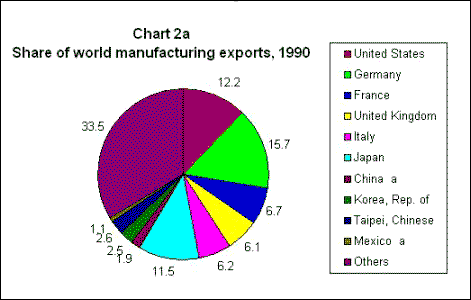The
issue of the international relocation of manufacturing
production is one which has received and continues
to attract a great deal of attention from not just
economists but policy makers, trade unions and other
analysts across the world. There is a general sense
that the past decade in particular has seen a significant
shift in the structure of international manufacturing
production, which is captured in the fact that developing
countries now account for nearly a quarter of world
manufacturing goods exports, up from just over one-tenth
two decades ago.
Such
relocation, which in turn is generally supposed to
imply a net loss of manufacturing jobs in the North
and a net expansion of such jobs in the South, has
been seen as being driven by both by the movement
of capital, as multinational companies in particular
move to areas characterised by cheaper labour, and
by trade liberalisation which has allowed manufactured
goods produced in Southern locations to penetrate
Northern markets. It is recognised that both of these
processes have been greatly facilitated by technological
change which has allowed for the locational breakup
of the productive process and the separation of various
elements of it with differing types of skill requirement.
This has enabled as "the
vertical disintegration of production",
with the associated geographical separation of different
parts of the production process and increase in intra-industry
trade.
It is sometimes argued that this has been accompanied
by a process in which manufacturing itself has become
less important, both in world production and world
trade, as various services activities play more significant
roles. However, as Chart 1 shows, during the 1990s,
manufacturing exports grew at reasonable rates throughout
the 1990s for most important categories of goods,
and for some, such as office and telecom equipment,
export growth was very rapid indeed.

Chart
1 >> Click
to Enlarge
Of course, within this, the shift in location of manufacturing
production from developed to developing countries
can be exaggerated. As Chart 2b indicates, even in
2000, certain developed countries dominated world
trade in manufactured goods. Indeed, the United States,
the European Union and Japan together still accounted
for more than 60 per cent of manufactured exports
in 2000. But what is evident is that the share of
the major developed country exporters had come down
even over the decade of the 1990s, continuing a process
that had begun earlier and was clearly evident in
the 1980s.
Thus, as is clear from a comparison of Charts 2a and
2b, the share of Germany in world manufacturing exports
fell quite sharply from 16 per cent to 10 per cent
over the decade, and most other major developed country
exporters experienced declines in their shares of
at least one percentage point or more. Only the United
States increased its share, from 12 to 14 per cent,
contrary to the widely held perception that it dominated
world manufactured goods trade only by virtue of its
huge capacity for manufactured imports. In contrast
to this, countries like the Peop0le's Republic of
China and Mexico managed to nearly triple their shares
(albeit from relatively low bases) over this period.

Chart
2a >> Click
to Enlarge

Chart 2b >> Click
to Enlarge

